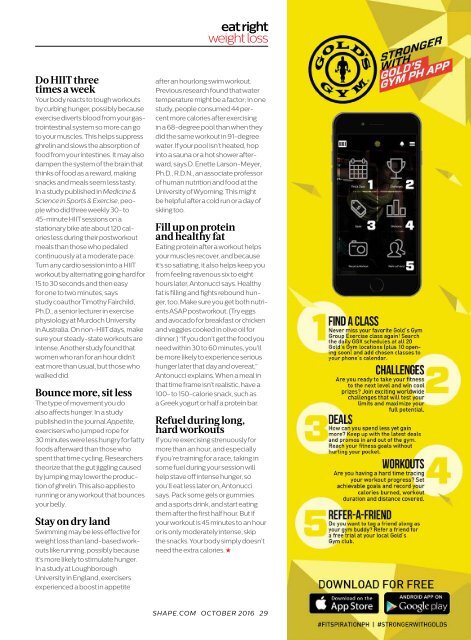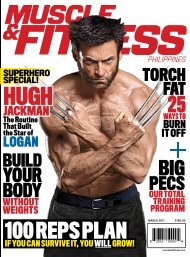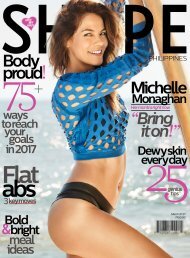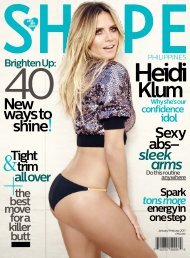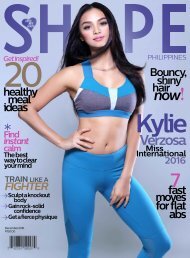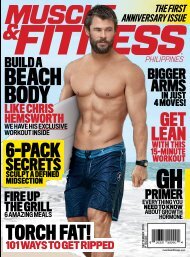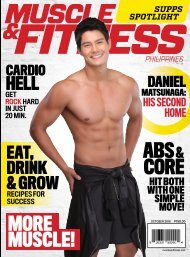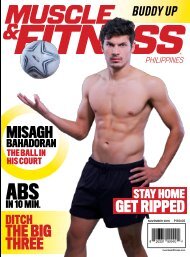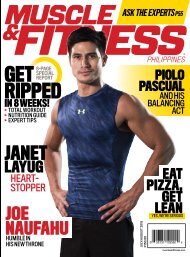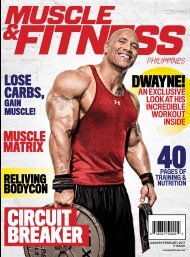SHAPE_OCTOBER_2016
You also want an ePaper? Increase the reach of your titles
YUMPU automatically turns print PDFs into web optimized ePapers that Google loves.
weight loss<br />
Do HIIT three<br />
times a week<br />
Your body reacts to tough workouts<br />
by curbing hunger, possibly because<br />
exercise diverts blood from your gastrointestinal<br />
system so more can go<br />
to your muscles. This helps suppress<br />
ghrelin and slows the absorption of<br />
food from your intestines. It may also<br />
dampen the system of the brain that<br />
thinks of food as a reward, making<br />
snacks and meals seem less tasty.<br />
In a study published in Medicine &<br />
Science in Sports & Exercise, people<br />
who did three weekly 30- to<br />
45-minute HIIT sessions on a<br />
stationary bike ate about 120 calories<br />
less during their postworkout<br />
meals than those who pedaled<br />
continuously at a moderate pace.<br />
Turn any cardio session into a HIIT<br />
workout by alternating going hard for<br />
15 to 30 seconds and then easy<br />
for one to two minutes, says<br />
study coauthor Timothy Fairchild,<br />
Ph.D., a senior lecturer in exercise<br />
physiology at Murdoch University<br />
in Australia. On non-HIIT days, make<br />
sure your steady-state workouts are<br />
intense. Another study found that<br />
women who ran for an hour didn’t<br />
eat more than usual, but those who<br />
walked did.<br />
Bounce more, sit less<br />
The type of movement you do<br />
also affects hunger. In a study<br />
published in the journal Appetite,<br />
exercisers who jumped rope for<br />
30 minutes were less hungry for fatty<br />
foods afterward than those who<br />
spent that time cycling. Researchers<br />
theorize that the gut jiggling caused<br />
by jumping may lower the production<br />
of ghrelin. This also applies to<br />
running or any workout that bounces<br />
your belly.<br />
Stay on dry land<br />
Swimming may be less effective for<br />
weight loss than land-based workouts<br />
like running, possibly because<br />
it’s more likely to stimulate hunger.<br />
In a study at Loughborough<br />
University in England, exercisers<br />
experienced a boost in appetite<br />
after an hourlong swim workout.<br />
Previous research found that water<br />
temperature might be a factor; in one<br />
study, people consumed 44 percent<br />
more calories after exercising<br />
in a 68-degree pool than when they<br />
did the same workout in 91-degree<br />
water. If your pool isn’t heated, hop<br />
into a sauna or a hot shower afterward,<br />
says D. Enette Larson-Meyer,<br />
Ph.D., R.D.N., an associate professor<br />
of human nutrition and food at the<br />
University of Wyoming. This might<br />
be helpful after a cold run or a day of<br />
skiing too.<br />
Fill up on protein<br />
and healthy fat<br />
Eating protein after a workout helps<br />
your muscles recover, and because<br />
it’s so satiating, it also helps keep you<br />
from feeling ravenous six to eight<br />
hours later, Antonucci says. Healthy<br />
fat is filling and fights rebound hunger,<br />
too. Make sure you get both nutrients<br />
ASAP postworkout. (Try eggs<br />
and avocado for breakfast or chicken<br />
and veggies cooked in olive oil for<br />
dinner.) “If you don’t get the food you<br />
need within 30 to 60 minutes, you’ll<br />
be more likely to experience serious<br />
hunger later that day and overeat,”<br />
Antonucci explains. When a meal in<br />
that time frame isn’t realistic, have a<br />
100- to 150-calorie snack, such as<br />
a Greek yogurt or half a protein bar.<br />
Refuel during long,<br />
hard workouts<br />
If you’re exercising strenuously for<br />
more than an hour, and especially<br />
if you’re training for a race, taking in<br />
some fuel during your session will<br />
help stave off intense hunger, so<br />
you’ll eat less later on, Antonucci<br />
says. Pack some gels or gummies<br />
and a sports drink, and start eating<br />
them after the first half hour. But if<br />
your workout is 45 minutes to an hour<br />
or is only moderately intense, skip<br />
the snacks. Your body simply doesn’t<br />
need the extra calories.<br />
<strong>SHAPE</strong>.COM <strong>OCTOBER</strong> <strong>2016</strong> 29


